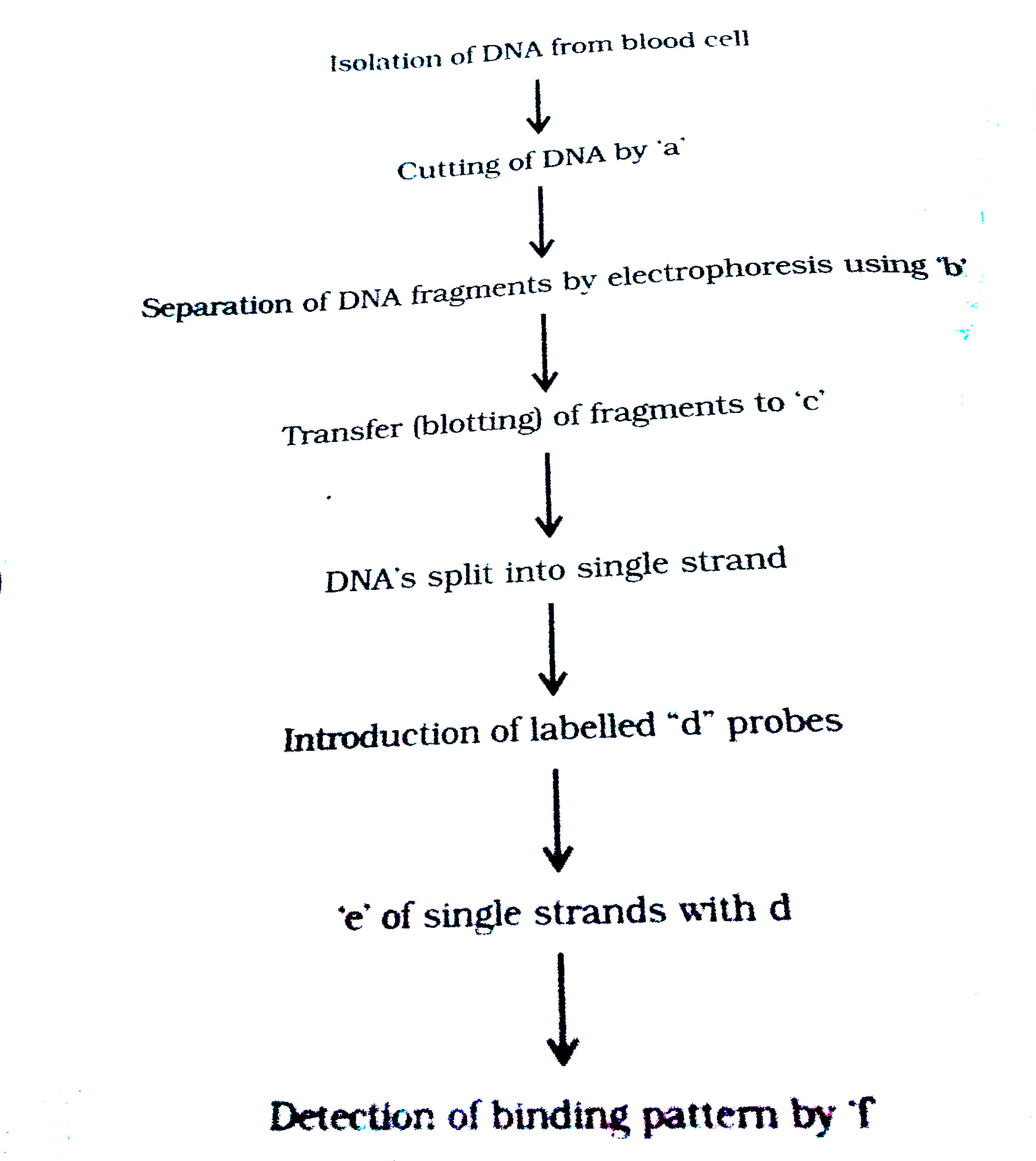Alec J. Jeffreys discovered the fundamental technique involved in DNA finger printing, while he was studying the gene for
dystrophin
myoglobin
haemoglobin
tubulin
The correct Answer is:B
Step-by-Step Text Solution:
1. Identify the Scientist and Context: The question refers to Alec J. Jeffreys, who is known for discovering the technique of DNA fingerprinting. This technique has significant applications in forensic science, paternity testing, and genetic identification.
2. Understand the Focus of Alec J. Jeffreys' Research: While developing the DNA fingerprinting technique, Jeffreys was studying a specific gene. The options provided are dystrophin, myoglobin, hemoglobin, and tubulin.
3. Analyze the Options:
- Dystrophin: A protein associated with muscular dystrophy, but not directly linked to Jeffreys' work.
- Myoglobin: A protein found in muscle tissue that binds oxygen, which is relevant to Jeffreys' research.
- Hemoglobin: The oxygen-carrying protein in red blood cells, but not the focus of Jeffreys' study.
- Tubulin: A protein that makes up microtubules, not related to Jeffreys' work.
4. Conclude the Correct Answer: After analyzing the options, it is determined that Alec J. Jeffreys was studying the gene for myoglobin when he discovered the fundamental techniques involved in DNA fingerprinting.
5. Summarize the Importance: Jeffreys' discovery of DNA fingerprinting has revolutionized forensic science and has become a crucial tool for identifying individuals based on their unique DNA profiles.
Final Answer: Alec J. Jeffreys discovered the fundamental technique involved in DNA fingerprinting while studying the gene for myoglobin.
---
- Dystrophin: A protein associated with muscular dystrophy, but not directly linked to Jeffreys' work.
- Myoglobin: A protein found in muscle tissue that binds oxygen, which is relevant to Jeffreys' research.
- Hemoglobin: The oxygen-carrying protein in red blood cells, but not the focus of Jeffreys' study.
- Tubulin: A protein that makes up microtubules, not related to Jeffreys' work.
Topper's Solved these Questions
- MOLECULAR BASIS OF INHERITANCEBook:AAKASH SERIESChapter:MOLECULAR BASIS OF INHERITANCEExercise:Exercise-II
Explore 124 Videos
- MOLECULAR BASIS OF INHERITANCEBook:AAKASH SERIESChapter:MOLECULAR BASIS OF INHERITANCEExercise:Exercise-II (DNA finger printing)
Explore 10 Videos
- MOLECULAR BASIS OF INHERITANCEBook:AAKASH SERIESChapter:MOLECULAR BASIS OF INHERITANCEExercise:Exercise-I (Human Genome project)
Explore 23 Videos
- MINERAL NUTRITIONBook:AAKASH SERIESChapter:MINERAL NUTRITIONExercise:Exercise - III
Explore 52 Videos
- NEURAL CONTROL AND COORDINATIONBook:AAKASH SERIESChapter:NEURAL CONTROL AND COORDINATIONExercise:EXERCISE-III( PREVIOUS AIPMT / NEET QUESTIONS)
Explore 33 Videos
Similar Questions
Knowledge Check
Paleontologists are using modern technology to gain a greater understanding of the distant past. With the aid of computed tomography (CT) scanning and 3-1) printing, researchers arc able to create accurate models of prehistoric fossils. 1These models have expanded researchers’ knowledge of ancient species and 2 swear to advance the field of paleontology in the years to come. CT scanners useX-rays to map the surface of a fossil in minute detail,recording as many as one million data points to createad igital blue print.A3-Dprinter then build sapolymer model based on this blueprint,much as a regular computer printer reproduces digital documents on paper. 3 Where as the head of an ordinary computer printer moves back and forth while printing ink on to paper,the corresponding part of a3-Dprinter moves in multiple dimensions while squirting out thin layers of melted polymer plastic.The plastic hardens quickly, 4 it allows the printer to build the layers of the final model.Compared with older ways of modeling fossils, scanning and printing in this way is extremely versatile.
One significant benefit of 3 D printing technology Is Its ability to creak scale reproductions of fossils, 121 Rut now 3 U scale models can be rearranged with ease, which is a huge boon to scientists 01 A team led by Drexel University professor Kenneth Lacovara is making models of dinosaur hones one-tenth the bones' original sizes in order to learn how they fit together when the animals were alive. [4] In the past,such research was limited by the weight and bulk of the fossils as well as 6 its preciousness and fragility.[5]In many cases,scientists had to rearrange bones virtually,using artists’renderings. 7 Because CTscanners can map objects that are impossible to excavate,CTscanning and 3-Dprinting canal so be used to reproduce fossils that scientists cannot observe first hand. 8 Bycontrast,researchers from the National Museum of Brazil 9 has relied on this technique to study a fossilized skeleton that was discovered protruding from a rock at anold SãoPaulo rail road site. 10 The fossil was too delicate to be removed from the rock.Because of the fossil’sdelicate nature,the team dug up a block of stone around the fossil and brought it to their lab.With the aid of a CTscanner and a3-Dprinter,they were able to produce are sin model of the fossil.Examining the model,there searchers determined that 11 one had found a new species,a 75-million-year-old crocodile.While notevery discovery will be as dramatic as this one,pale on to logists anticipate further expanding their knowledge of ancient life-forms asCTscanning and 3-Dprinting continue to make fossils more accessible.
ANO CHANGEBit'sCtheirDthere
DNA finger printing technique is based on
View SolutionDNA finger printing is useful for study of :
View SolutionWhich step does not involve in DNA finger printing
View SolutionAlec Jeffreys developed the DNA fingerprinting technique. The probe he used was
View SolutionRead the following statements.
A. Variation at genetic level arises due to mutations.
B. Technique of DNA finger printing was initially developed by Alec Jeffreys .
View SolutionThe following is the flow chart highlighting the steps in DNA finger printing technique. Identify a, b, c, d, e and f.

View SolutionThe technique involving insertion of a desired gene into the DNA of plasmid vector is know as
View Solution

